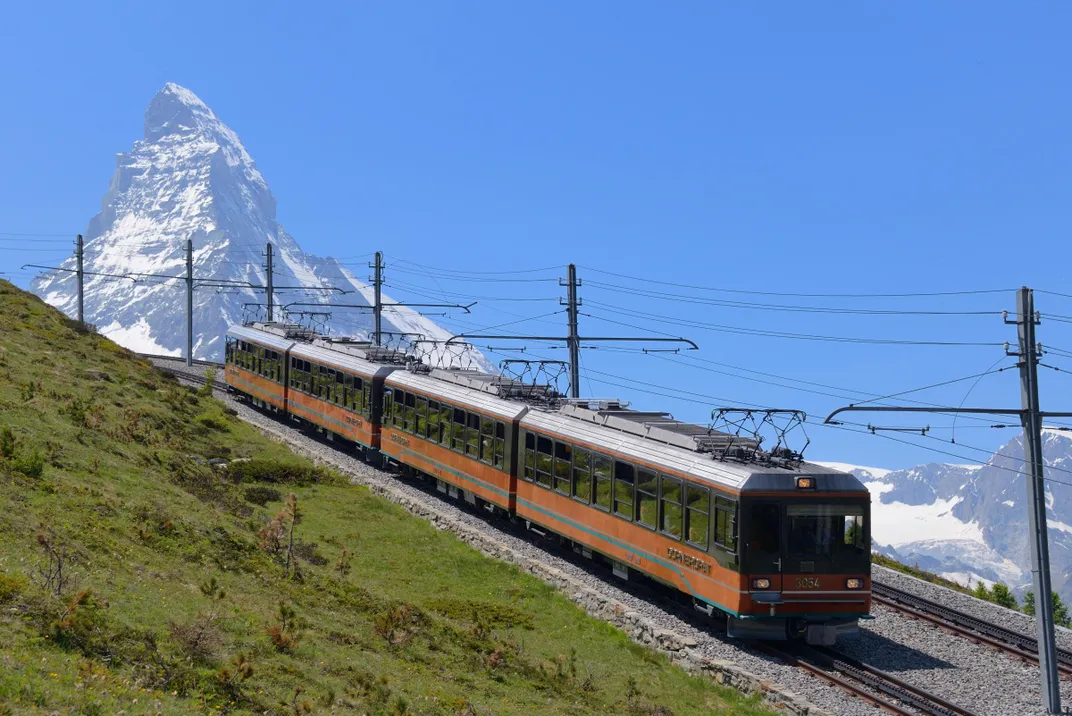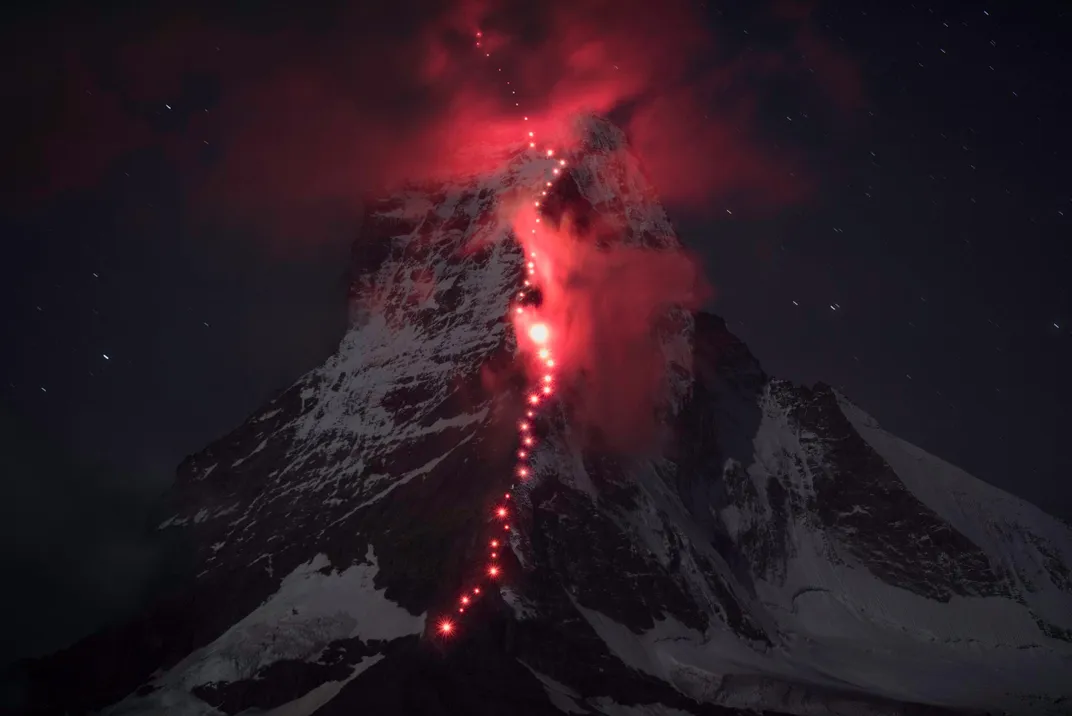Seven Surprising Facts About the Matterhorn
The towering peak that straddles Switzerland and Italy is full of secrets
:focal(898x449:899x450)/https://tf-cmsv2-smithsonianmag-media.s3.amazonaws.com/filer/9e/fa/9efad142-22d0-481f-9738-49e516b732b1/42-81494958.jpg)
Out of all of the mountains that make up the Alps, the Matterhorn is probably the best known. Meaning “peak in the meadows” in German, the nearly 15,000-foot-tall mountain straddles the Swiss-Italian border and has long been a bucket list destination for climbers. Taller peaks like Mount Everest and K2 may overshadow it in terms of height, but the Matterhorn’s seemingly eternal pop-culture presence makes it easily recognizable to people around the world.
Here are seven things you might not know about the majestic mountain.
The first ascent to the summit ended in tragedy
/https://tf-cmsv2-smithsonianmag-media.s3.amazonaws.com/filer/0e/c5/0ec56328-1d64-4c08-8ced-60e2651de2c4/42-74772350.jpg)
On July 14, 1865, a seven-member team of climbers made the first ascent to the top of the Matterhorn using ropes woven out of manila hemp, but only three lived to tell about it. As the group descended using the Hörnligrat route (the mountain’s shoulder), one of the climbers slipped pulling three others down with him. As the climbers above anchored themselvs to absorb the shock on the lifeline, the rope snapped between the fourth and fifth man, and Michel Croz, Rev. Charles Hudson, Douglas Hadow and Lord Francis Douglas fell to their deaths. Douglas' body was never found.
Over the years, an estimated 500 people have died attempting to climb the Matterhorn, and a metal cross at the peak commemorates those who lost their lives on the mountain. The Matterhorn Museum Zermatlantis, located in the resort town of Zermatt below the peak, currently has an exhibit focused on that fateful first ascent. Visitors can see the section of broken rope displayed behind glass on a velvet pillow.
Each face of the peak points toward one of the cardinal directions
/https://tf-cmsv2-smithsonianmag-media.s3.amazonaws.com/filer/de/12/de129c1a-a9f3-4246-bd1a-c677a58983ea/42-70611896.jpg)
The Matterhorn formed millions of years ago when several land masses slammed into one another, forcing the ground upward. Geologists have determined that the hard gneiss rock on top of the mountain came from the African continental plate as it smashed into the Laurasian, or European plate. Hence, the mountain could technically be considered African.
The resulting pyramid-shaped peak has four distinct sides that align with the cardinal directions: north, south, east and west. The north side faces Zermatt Valley and the east overlooks Gornergrat Ridge, both in Switzerland, while the south face points toward the Italian town of Brueil-Cervinia and the western side overlooks the Swiss-Italian border.
There's an igloo village at the mountain's base
/https://tf-cmsv2-smithsonianmag-media.s3.amazonaws.com/filer/28/e5/28e50b42-0268-4a9d-8847-0052de3518c6/42-81674920.jpg)
Carved out of snow and ice, Iglu-Dorf in the town of Zermatt at the base of the Matterhorn is home to the world’s largest snow igloo, with an interior diameter of 42 feet and a height of 34 feet. The igloo resort includes more than a half-dozen individual igloos or hotel rooms interconnected by a series of tunnels, as well as a bar and restaurant.
Two women waged a fierce battle to be the first female to the summit
/https://tf-cmsv2-smithsonianmag-media.s3.amazonaws.com/filer/f8/e1/f8e1dc1b-c75b-4e37-a46b-c7f1aec7cab8/meta-brevoort-and-ronald-w-clark_front_magnific.jpg)
On July 22, 1871 an Englishwoman named Lucy Walker became the first woman to reach the top of the Matterhorn—and she did it while wearing a long flannel skirt. When she got word that her rival Meta Brevoort, a fellow climber failed to summit a few years earlier due to bad weather, was also headed to Zermatt, Walker made a beeline for the mountain and started climbing. Soon, news of Walker's success spread across the globe. Undeterred, Brevoort made a successful climb to the summit too. She reached the top a few days after Walker—the first woman to reach the top via the Italian side of the mountain.
Vintage tourism posters of the mountain can fetch thousands of dollars at auction
/https://tf-cmsv2-smithsonianmag-media.s3.amazonaws.com/filer/b1/c3/b1c32cb2-b8bd-4c88-93aa-19c1282b9f77/42-76632075.jpg)
Switzerland was one of the first countries in the world to use posters as a way to entice travelers to visit. One of the most famous of those early travel posters is of the Matterhorn itself. Artist Emil Cardinaux’s famous poster of the peak, which he created in 1908, fetched nearly $10,000 at auction.
The peak almost got its own railroad

In the late 19th century, rumors of a proposed construction project that would bring train access to Matterhorn's summit swirled throughout Switzerland. The idea never gained much traction, but at the time, pioneer Heinz Schild was so certain that the project would come to fruition that he even wrote a book about it. What Schild didn't expect was the outcry from local citizens who petitioned against the project, arguing "the peaks of the Alpine mountains are the ideological property of the entire Swiss population and hence are not for sale" to developers.
Today, a train called Gornergrat Bahn, the world's first open-air cog railway, runs between Zermatt and Gornergrat. Alas, it doesn't reach the summit.
For one night, the mountain glowed red

In 2015, 150 years after the first ascent up the mountain, a team of Mammut-sponsored guides retraced the steps of the first climbers by placing hundreds of glowing red lights along the mountain's ridge. The result was a temporary light installation meant to recognize the mountaineers who made that original ascent and the lives lost during that incredible journey.
Planning Your Next Trip?
Explore great travel deals
Smithsonian magazine participates in affiliate link advertising programs. If you purchase an item through these links, we receive a commission.